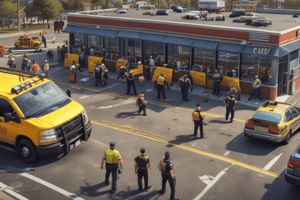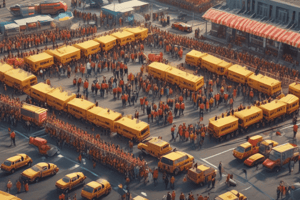Podcast
Questions and Answers
What is the minimum distance the Civil Disturbance Management contingent should maintain from a public assembly?
What is the minimum distance the Civil Disturbance Management contingent should maintain from a public assembly?
- 100 meters (correct)
- 200 meters
- 150 meters
- 50 meters
Which items are permitted for CDM members to carry during civil disturbance management operations?
Which items are permitted for CDM members to carry during civil disturbance management operations?
- Firearms and shields
- Tear gas and batons
- Batons and riot sticks (correct)
- None of the above
What should be the primary approach of the Ground Commander during a public assembly?
What should be the primary approach of the Ground Commander during a public assembly?
- Ignore the demonstrators
- Issue arrest orders immediately
- Encourage dialogue and peaceful dispersal (correct)
- Deploy riot gear at once
Under which circumstances can tear gas or similar devices be used?
Under which circumstances can tear gas or similar devices be used?
How should officers physically restrain individuals during violent dispersal?
How should officers physically restrain individuals during violent dispersal?
What is the recommended policy for dealing with demonstrators during civil disturbance situations?
What is the recommended policy for dealing with demonstrators during civil disturbance situations?
Which of the following actions is prohibited during crowd control operations?
Which of the following actions is prohibited during crowd control operations?
Which aspect of police uniforms is emphasized in the guidelines?
Which aspect of police uniforms is emphasized in the guidelines?
Flashcards
CDM Contingent Position
CDM Contingent Position
The Civil Disturbance Management contingent should be positioned at least 100 meters away from the area of the public assembly.
CDM Uniforms
CDM Uniforms
CDM members should wear prescribed uniforms without firearms but may carry batons, shields, helmets, gas masks, and protective gear.
Maximum Tolerance
Maximum Tolerance
The CDM contingent should adhere to a policy of maximum tolerance when dealing with demonstrators.
Tear Gas Use
Tear Gas Use
Signup and view all the flashcards
Violent Dispersal Restraint
Violent Dispersal Restraint
Signup and view all the flashcards
Proper Arrest Techniques
Proper Arrest Techniques
Signup and view all the flashcards
Police Interference?
Police Interference?
Signup and view all the flashcards
Dialogue with Organizers
Dialogue with Organizers
Signup and view all the flashcards
Study Notes
General Guidelines for Civil Disturbance Management Operations
- Police units maintain peace and order, but do not interfere with public gatherings.
- A Civil Disturbance Management contingent, headed by a police captain, is positioned at least 100 meters from the assembly area.
- The Ground Commander encourages demonstrators to peacefully disperse.
- Dialogue with leaders is initiated by the commander.
- If an agreement for dispersal fails, orderly dispersal and arrest of responsible individuals is conducted.
Specific Guidelines for Civil Disturbance Management Operations
- CDM members wear prescribed uniforms, without firearms, but may carry batons or riot sticks, crash helmets with visors, gas masks, and appropriate footwear.
- Tear gas, smoke grenades, and water cannons are allowed only when there's actual or serious threat of violence or damage.
- CDM contingents operate by maximum tolerance when dealing with demonstrators.
- Selection and deployment of CDM contingents adhere to PNP rules and regulations.
Human Rights Advisory for PNP Personnel on Crowd Control/CDM
- PNP units maintain peace and order and should not interfere with gatherings, ensuring public safety and maintaining peace.
- A police CDM contingent, led by a Police Senior Investigator, is detailed and stationed at least 100 meters from the activity area.
- CDM contingents must wear prescribed uniforms without firearms, and carry appropriate equipment.
- CDM contingents enforce policies of "maximum tolerance".
- During violent dispersal, only resisting people are targeted on fleshy areas, avoiding sensitive body parts.
- Tear gas, smoke grenades, water cannons, etc, are used only if the gathering involves violence, threats, or property damage.
- Proper control and handcuffing techniques are used, without dragging protestors.
Studying That Suits You
Use AI to generate personalized quizzes and flashcards to suit your learning preferences.
Description
This quiz covers the essential guidelines for managing civil disturbances, focusing on the protocols police units must follow to maintain order while respecting public gatherings. Understand the roles, responsibilities, and tools used by Civil Disturbance Management members in various scenarios. Test your knowledge on the strategies for dialogue, dispersal, and ensuring safety.





